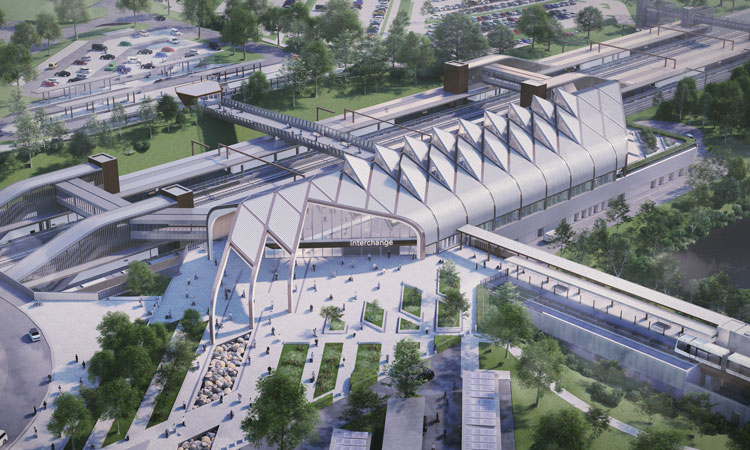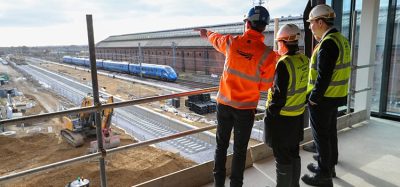HS2’s Interchange Station wins top environmentally-friendly design award
Posted: 5 May 2020 | Global Railway Review | 1 comment
HS2’s new Interchange station has become the first railway station in the world to achieve the BREEAM ‘Outstanding’ certification, a top award for environmentally-friendly design.


Interchange Station visual. Credit: HS2 Ltd
The new HS2 station, to be built near Solihull and the NEC in the West Midlands, has become the first railway station globally to achieve the BREEAM ‘Outstanding’ certification – a measure of sustainability for new and refurbished buildings – putting it in the top one per cent of buildings in the UK for eco-friendly credentials.
This landmark award recognises the station’s eco-friendly features, including maximising natural daylight and ventilation, a station roof design which can capture and reuse rainwater, and features to enable net zero carbon emissions from day-to-day energy consumption.
BREEAM is the Building Research Establishment’s Environmental Assessment Method. It sets the standard for best practice in sustainable design and has become the de facto measure used to describe the sustainability performance of buildings. The Interim Certificate, awarded at the design stage to Interchange Station confirms an ‘Outstanding’ rating, putting it in the top one per cent of buildings in the UK, and the first for any railway station in the world.
Minimising demand for carbon
The station’s design includes minimising demand for carbon through the use of natural ventilation and daylighting. Energy efficient technology will be incorporated, such as air source heat pumps and LED lighting. In addition, the station and Automated People Mover maintenance facility have over 2,000m2 of solar panels generating zero carbon electricity.
Directing rainwater from the main station building via a network of underground pipes into a rainwater harvesting tank will assist in providing part of the building’s water requirements. The estimated volume of the rainwater harvesting tank is 150m3 which will reduce the mains water demand for the station. The landscaping features sustainable drainage systems to reduce the burden on surface water drainage whilst naturally irrigating planted areas, and there will be new natural habitats created around the station, leaving a legacy of biodiversity and an enhancement of native species.
There will be 222 electric vehicle charging points in the car parking, and cycle storage for 176 bicycles with further room for expansion as demand dictates. There will also be dedicated pedestrian access into the station from the east of the railway, along with cycle access to the new station from the north, west and south-east through a mixture of dedicated routes.
Peter Miller, HS2’s Environment and Town Planning Director, said: “Our aim is to design, construct and operate HS2 to reduce carbon and to minimise the effect of the project on the environment. Our stations will be amongst the most environmentally-friendly stations in the world, so this certification is fantastic news for Interchange station. In building the station, we are also committed to sourcing and making efficient use of sustainable materials, reducing waste and maximising the proportion of material diverted from landfill.”
Peter continued: “All leading environmental organisations agree that climate change is the biggest future threat to wildlife and habitats in the UK. By providing a cleaner, greener way to travel, HS2 will help cut the number of cars and lorries on our roads, cut demand for domestic flights, and help the country’s drive to net zero carbon emissions.”
Ambitious net zero carbon targets
As part of its commitment to managing carbon footprint, HS2 has also set ambitious targets for its supply chain to minimise the whole life carbon emissions of its assets including buildings. For stations this includes achieving net zero carbon in operation for regulated emissions and achieving a 50 per cent reduction in whole life carbon emissions against a baseline for a typical station. The HS2 and Arup teams working on the Interchange Station have developed design solutions which achieve this ambition through the use of renewable technologies and lean design as well as achieving a holistic sustainable design in the wider landscaping and urban realm.
The station design scored highly on a broad range of criteria including Health and Wellbeing, Energy, Transport, Water, Materials, Waste, Land Use and Ecology, and Pollution. In addition a further seven exemplar credits were achieved at design stage, including one for committing to undertaking a Post Occupancy Evaluation (POE) of the building to monitor its energy and water usage against the design predictions, three credits for generating a material efficiency metric and analysis into the embodied carbon of specified building materials, one for a commitment to manage construction traffic and the installation of electric vehicle charging points, and for achieving a higher standard of resilience to climate change.
Related topics
High Speed Two (HS2), High-Speed Rail, Infrastructure Developments, Station Developments, Sustainability/Decarbonisation, The Supply Chain








Thank you For Amazing Information. Such a BREEAM ‘Outstanding’ certification is the Biggest achievement for HS2’s Interchange Station.
I am very inspiring this blog.
Thank’s